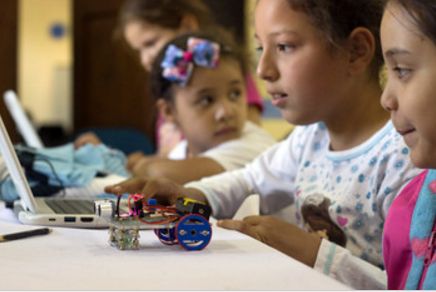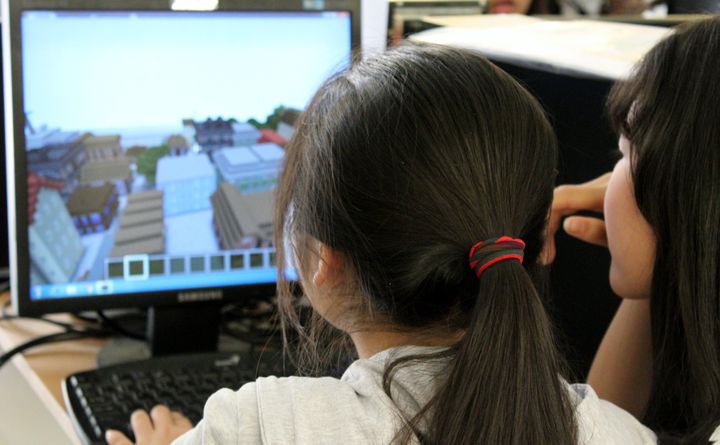
Girls in Paraguay building a robot
“I want the next generation of Mark Zuckerbergs and Jack Dorseys to be women.” These were the words spoken by Reshma Saujani, Founder of Girls Who Code, at the Women Opening Doors for Women conference in 2013.
It’s a sentiment that few people would disagree with. But four years later, there are still 200 million more women than men who do not have a mobile phone, and the gender gap in internet access is growing, not shrinking. It’s almost incomprehensible that such gaps exists in 2017, especially given the clear benefits of ensuring women and girls have access to technology and are part of creating it. An array of studies show that empowering girls and women to use technology has diverse ripple effects, from increased GDP, to stronger earning potential for women, and more diverse technology and digital content that better reflects the needs and priorities of a wider audience.
Girls and women have the right to benefit from information and communication technologies (ICTs), and participate in creating new technology and digital solutions. It is as simple as that. But we need to dismantle barriers, break stereotypes and move obstacles that are currently preventing women and girls from being able to reap the benefits of technology.
Everywhere in the world, women and girls are underrepresented in ICT study programs and careers. This is not down to a lack of interest, but rather stereotyping. The kind that means computers, engineering and technology are often viewed as something boys and men are just ‘naturally’ more fit for. These kind of stereotypes are not only inaccurate, but harmful. They put women and girls in boxes based on nothing but their biological sex, indicating which fields we are more or less suitable for. This discourages girls and women from entering ICT careers, and can also make these fields quite hostile environments for them to work in.
These are some of the many reasons why today we celebrate the International Girls in ICT Day. Spearheaded by the International Telecommunications Union, the day aims to encourage more girls to consider studies and careers in the ICT field and create a supportive and an enabling environment. One day is of course not enough – removing barriers that currently prevent girls and women from being able to benefit from the advances of technology and participate in ICT careers equally with boys and men requires long-term, holistic and systematic actions and interventions in both private and public sector.
This video was produced by Plan International in Ethiopia, together with local young girls as the actors.
So what can be done? To start, institutions and companies should be strongly encouraged to ensure gender equality in hiring practices, or to implement policies such as anonymous hiring where applications do not have to include the applicants name, sex or other information that could indicate gender (or other traits like religion and ethnicity, which can also be causes for discrimination). Girls need role models and mentors to look up to – it can be hard to aspire for something you do not see. While in some cases it might be smart to organize girls-only activities, like coding classes and computer workshops, it is also important to engage boys and men to change their behavior and perception about girls’ and women’s participation in the ICT field.
For organizations working in the field of international development, this issue is of particular importance. The gender gaps in access to and use of technology are biggest in emerging markets, where women’s and girls’ employment and income earning possibilities are already often restricted by multiple factors, including patriarchy and rigid gender roles. Girls and women lacking essential digital skills is yet another barrier to empowerment, independence and participation which prevents them from realizing their true potential. This is why Plan International is working hard to do its part in bridging the digital gender divide by implementing programmes that allow girls to learn crucial computer skills and use technology to improve their lives.

Vietnamese girls using Minecraft to improve their surroundings.
On Girls in ICT Day, we are encouraging our offices and partners to bring awareness to the gender digital divide and come up with concrete actions and solutions to improve girls’ and women’s access to technology, remove barriers, change norms and attitudes and create a more encouraging and enabling environment for girls in the technology sector. This isn’t something we can afford to ignore, nor can we leave it to just one day a year. Without ensuring girls and women are able to access, use and create technology equally with boys and men, we will fail in our quest to empower women and girls and realize gender equality. Our job is to open doors, break down obstacles, change hearts and minds and allow women and girls to be the changemakers and trailblazers of ICT fields, not 10 years from now, not one year from now, not tomorrow – but today.
Join the discussion online with #GirlsinICT and #DigitalGirls and share why you think it is important for girls and women to have access to technology!
